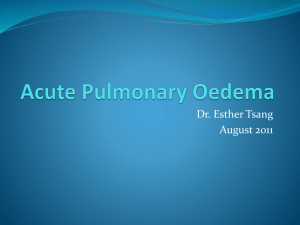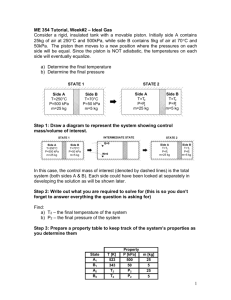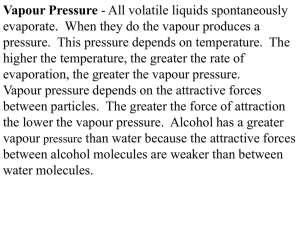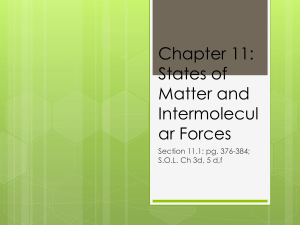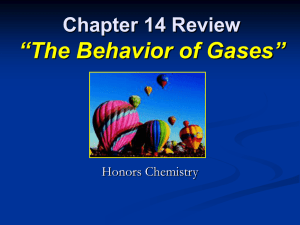Solutions
advertisement
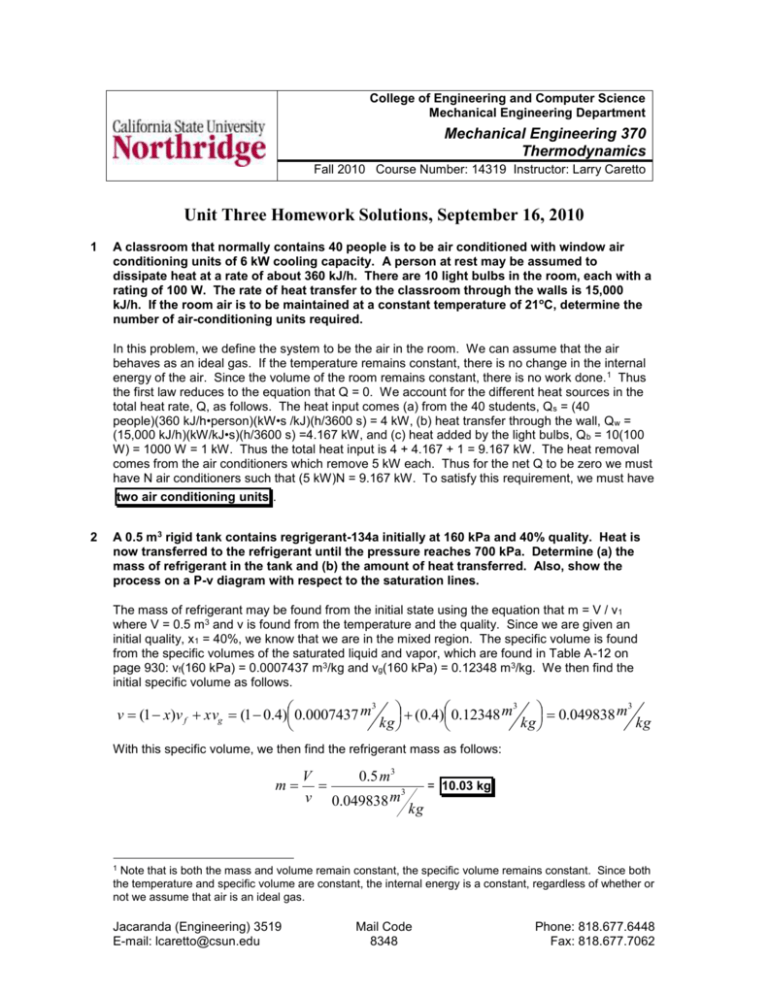
College of Engineering and Computer Science Mechanical Engineering Department Mechanical Engineering 370 Thermodynamics Fall 2010 Course Number: 14319 Instructor: Larry Caretto Unit Three Homework Solutions, September 16, 2010 1 A classroom that normally contains 40 people is to be air conditioned with window air conditioning units of 6 kW cooling capacity. A person at rest may be assumed to dissipate heat at a rate of about 360 kJ/h. There are 10 light bulbs in the room, each with a rating of 100 W. The rate of heat transfer to the classroom through the walls is 15,000 kJ/h. If the room air is to be maintained at a constant temperature of 21oC, determine the number of air-conditioning units required. In this problem, we define the system to be the air in the room. We can assume that the air behaves as an ideal gas. If the temperature remains constant, there is no change in the internal energy of the air. Since the volume of the room remains constant, there is no work done. 1 Thus the first law reduces to the equation that Q = 0. We account for the different heat sources in the total heat rate, Q, as follows. The heat input comes (a) from the 40 students, Qs = (40 people)(360 kJ/h•person)(kW•s /kJ)(h/3600 s) = 4 kW, (b) heat transfer through the wall, Q w = (15,000 kJ/h)(kW/kJ•s)(h/3600 s) =4.167 kW, and (c) heat added by the light bulbs, Q b = 10(100 W) = 1000 W = 1 kW. Thus the total heat input is 4 + 4.167 + 1 = 9.167 kW. The heat removal comes from the air conditioners which remove 5 kW each. Thus for the net Q to be zero we must have N air conditioners such that (5 kW)N = 9.167 kW. To satisfy this requirement, we must have two air conditioning units . 2 A 0.5 m3 rigid tank contains regrigerant-134a initially at 160 kPa and 40% quality. Heat is now transferred to the refrigerant until the pressure reaches 700 kPa. Determine (a) the mass of refrigerant in the tank and (b) the amount of heat transferred. Also, show the process on a P-v diagram with respect to the saturation lines. The mass of refrigerant may be found from the initial state using the equation that m = V / v 1 where V = 0.5 m3 and v is found from the temperature and the quality. Since we are given an initial quality, x1 = 40%, we know that we are in the mixed region. The specific volume is found from the specific volumes of the saturated liquid and vapor, which are found in Table A-12 on page 930: vf(160 kPa) = 0.0007437 m3/kg and vg(160 kPa) = 0.12348 m3/kg. We then find the initial specific volume as follows. 3 (0.4) 0.12348 m3 0.049838 m3 v (1 x)v f xvg (1 0.4) 0.0007437 m kg kg kg With this specific volume, we then find the refrigerant mass as follows: m V 0.5 m3 v 0.049838 m3 = 10.03 kg kg 1 Note that is both the mass and volume remain constant, the specific volume remains constant. Since both the temperature and specific volume are constant, the internal energy is a constant, regardless of whether or not we assume that air is an ideal gas. Jacaranda (Engineering) 3519 E-mail: lcaretto@csun.edu Mail Code 8348 Phone: 818.677.6448 Fax: 818.677.7062 Unit three homework solutions ME 370, L. S. Caretto, Fall 2010 Page 2 To compute the heat transfer we apply the first law, Q = U + W. We assume that there is no volume change in the “rigid” tank. If there is no volume change, no work is done. With W = 0, Q = U. We find U = m(u2 – u1) where the specific internal energies are found from the property tables. At the initial state we find u from the quality in the same way that we found the volume. u (1 x)u f xug (1 0.4) 31.09 kJ (0.4) 221.35 kJ 107.19 kJ kg kg kg When we try to find the final state (P = 700 kPa, v = 0.049838 m3/kg) in the superheat table, A-13, on page 930, we see that the final specific volume in the table for P = 700 kPa = 0.70 MPa (at a temperature of 160oC) is only 0.048597 m3/kg. Furthermore, the specific volume is increasing with temperature so that the final state is at a higher temperature than the final temperature in the table. Problem 4-282 Plot for Problem 10000 Saturation Path 1000 Pressure (kPa) Because this is a constant volume process, the final state has the same specific volume as the initial state (0.049838 m3/kg) and a given pressure of 700 kPa. Knowing these data we can plot the constant volume path for this process as shown in the figure at the left. We see that the initial state (1) is in the mixed region and the increase in pressure, at constant volume, brings the final state into the gas region. 2 1 100 10 0.0001 0.001 0.01 0.1 The internal energy at the final state 3 can be found by extrapolation beyond Specific volume (m /kg) the last value in the table, using the same formula as for interpolation, with the last two points in the table. u 357.41kJ kg 367.29 kJ 0.048597 m kg 3 kg 357.41kJ 0.049838 m3 0.047306 m3 376.79 kJ kg kg kg kg 0.047306 m 1 3 kg We can now find the heat transfer as follows. Q m(u 2 u1 ) (10.03 kg) 376.79 kJ 107.19 kJ = 2,705 kJ kg kg 3 A 20 ft3 rigid tank contains saturated regrigerant-134a vapor at 160 psia. As a result of heat transfer from the refrigerant, the pressure drops to 50 psia. Show the process on a Pv diagram with respect to the saturation lines, and determine (a) the final temperature, (b) the amount of refrigerant that has condensed, and (c) the heat transfer. The solution of this problem is similar to the previous one. It is a constant volume process so that the work is zero and the heat transfer equals the change in internal energy. The P-v diagram for this problem is shown below. The process starts at the saturated vapor line at 120 psia and as heat is removed, some refrigerant condenses, moving the process into the mixed region at the final state where P2 = 50 psia.. Unit three homework solutions ME 370, L. S. Caretto, Fall 2010 Page 3 Since the final state is in the mixed region, we know that the final temperature is the saturation temperature at the final pressure of 50 psia. From table A-12E on page 977, we find that the final temperature, Tsat(50 psia) = 40.23oF . V 20 ft 3 m v 0.29316 ft 3 68.222 lbm Problem 4-29E 3 1000 Saturation Path Pressure (psia) The amount of refrigerant that has condensed is the total mass minus the mass that is vapor at the final state. This is m – x2m. We can find the total mass from the specific volume at the initial state and the total volume of the container: m = V/v1, where v1 is the volume of the saturated vapor, vg, at the initial pressure of 160 psia. From Table A-12E on page 977 we find that vg(160 psia) = 0.29316 ft3/lbm, so that the total mass is given by the following equation. 100 2 lbm The specific volume at the final state is the same as the initial specific volume, so we can find the quality at this final state from the saturated liquid and vapor specific volumes at the final pressure of 50 psia, taken from Table A12E. x 1 v vf vg v f 10 0.0001 0.01 0.1 1 10 3 Specific volume (ft /lbm ) 3 0.28316 ft 0.94791 ft 0.001 lbm 3 lbm 3 0.01252 ft 0.01252 ft lbm 3 0.3000 lbm The mass condensed can now be found. mcondensed = m – mx2 = (1 – x2) m = ( 1 – 0.3000 ) ( 68.222 lbm ) = 47.75 lbm . We have to find the internal energy at the initial and final states to compute the heat transfer. The initial internal energy is simply ug(160 psia) = 108.50 Btu/lbm (Table A-12E). The internal energy at the final state is found from the saturation properties and the quality, x2 = 0.3000. u 2 (1 x2 )u f ( P2 50 psia ) x2u g ( P2 50 psia ) (0.3000)100.69 Btu 47.396 Btu (1 0.3000) 24.832 Btu lbm lbm lbm The heat transfer can now be found from the first law. Q = U + W = m(u2 – u1) + W = (68.222 lbm)(47.396 – 108.50) Btu/lbm + 0 = –4 ,169 Btu . Unit three homework solutions 4 ME 370, L. S. Caretto, Fall 2010 Page 4 An insulated piston-cylinder device contains 5 L of saturated liquid water at a constant pressure of 175 kPa. Water is stirred by a paddle wheel while a current of 8 A flows for 45 min through a resistor placed in the water. If one half of the liquid is evaporated during this constant-pressure process and the paddle-wheel work amounts to 400 kJ, determine the voltage of the source. Also, show the process on a P-v diagram with respect to the saturation lines. In this problem we assume that the insulation on the piston-cylinder device reduces the heat transfer to a negligible amount so that we may assume that Q = 0. The evaporation of the liquid comes from the addition of work from the resistor and the paddle wheel. At the same time, the piston is expanding, at constant pressure, so that the water is doing work. Since the pressure is constant, this work is simply equal to P(V2 – V1). For this problem the first law becomes: Q = 0 = U + W = m(u2 – u1) + P(V2 – V1) + W resistor + W paddle We can write the volumes as the product of mass times specific volume and use the fact that P = P1 = P2 to introduce the enthalpy, h = u + Pv. –W resistor – W paddle = m(u2 – u1) + Pm(v2 – v1) =m[(u2 + P2v2) – (u1 + P1v1)] = m(h2 – h1) We can find the mass from the initial state where we know V1 = 5 L and v1 = vf(P1 = 175 kPa). Using Table A-5 on page 916 to find vf, we compute the mass as follows. V V1 5L m 1 v1 v f (175 kPa) 0.001057 m3 kg 0.001m3 4.730 kg L Since the paddle wheel and resistance work are inputs, these are negative. Thus the values of W resistor and W paddle are –EIt and –400 kJ, where E is the voltage that we want to find and I is the given current of 8 A. The enthalpy at the initial state is simply hf at 175 kPa. The enthalpy at the final state is the enthalpy of a mixture with a quality of 50% at the same 175 kPa pressure. We thus have h1 = hf(175 kPa) = 487.01 kJ/kg, where we use Table A-5 for the saturation data. Using the same table and the value of x2 = 50% we find h2 as follows. h2 h f xh fg 487.01 kJ (0.5) 2213.1 kJ 1593.56 kJ kg kg kg Substituting the work terms and enthalpy and mass into our first law gives an equation for the unknown voltage. –W resistor – W paddle = EIt + 400 kJ = m(h2 – h1) = (4.730 kg)(1593.56 – 487.01) kJ/kg Combining the numerical data gives an equation for the work done by the resistor. EIt = 4834 kJ = 4834 kW•s We can solve this to find the voltage applied to the resistor. E 4834 kW s 4834 kW s 1 m 1000 V A = 224 V . I t (8 A)( 45 m) 60 s kW Unit three homework solutions 5 ME 370, L. S. Caretto, Fall 2010 Page 5 A piston-cylinder device initially contains steam at 200 kPa, 200oC, and 0.5 m3. At this state a linear spring (F x) is touching the piston but exerts no force on it. Heat is now slowly transferred to the steam causing the pressure and the volume to rise to 500 kPa and 0.6 m3, respectively. Show the process on a P-v diagram with respect to the saturation lines and determine (a) the final temperature, (b) the work done by the steam, and (c) the total heat transferred. The path for this process is shown in the diagram below. The initial point of the path is (P1, V1) = (200 kPa, 0.5 m3); the final point is (P2, V2) = (500 kPa, 0.6 m3). P2 P P1 V V1 V2 The linear path results from the linear relationship between spring force and displacement and the linear relationship between displacement and volume. The equilibrium point of the spring occurs at the initial volume, since the spring is touching the piston but exerting no force at this point. The pressure due to the spring is then given by the following equation. V V1 F k ( x xe ) A k V V1 Pspring A A A A2 k The total pressure, P, acting on the water will be the sum of the constant pressure from the weight of the piston (and atmospheric pressure), P1, and Pspring. P P1 Pspring P1 k V V1 A2 This equation is seen to provide a linear relationship between pressure and volume as shown in the diagram above. The work is the area under the path which is the area of a trapezoid: W = (P1 + P2)(V2 – V1)/2. Using the values of pressure and volume given in the problem allows us to find the work. W P1 P2 ( 200 500) kPa kJ (V2 V1 ) 0.6 m 3 0.5 m 3 35 kJ 2 2 kPa m 3 The heat transfer is given by the first law: Q = U + W = m(u2 – u1) + W. We have to find the values of u1 and u2 from the property tables for water. In addition, we can find the mass from the initial volume, V1 = 0.5 m3, and the initial specific volume, v1. At the initial state of P1 = 200 kPa and T1 = 200oC, we find the following properties in the superheat table, Table A-6 on page 918: v1 = 1.08049 m3/kg and u1 = 2654.6 kJ/kg. We can then find the mass as follows. V1 0.5 m3 m v1 1.08049 m3 0.46275 kg kg Unit three homework solutions ME 370, L. S. Caretto, Fall 2010 Page 6 From this system mass, we can compute the specific volume at the final state where V2 = 0.6 m3. 3 V2 0.6 m3 v2 1.2966 m kg m 0.46275 kg At the final pressure of 500 kPa, the specific volume, v2 = 1.2966 m3/kg occurs between temperatures of 1100oC and 1200oC in Table A-6 on page 920. Interpolating between these two points gives the temperature and internal energy at the final state. u 4259.0 kJ T 1100o C kg 4470.0 kJ 4259.0 kJ 3 3 kg 1.2966 m kg 1.26728 m kg 4325.8 kJ kg ` 3 1.35972 m 1.26728 m kg kg kg 3 1200o C 1100o C 1.2966 m3 1.26728 m3 1131.7 o C ` 3 3 kg kg 1.35972 m 1.26728 m kg kg So, the final temperature, T2 = 1132oC . The heat transfer is found from the first law as usual. Q = m(u2 – u1) + W = (0.46275 kg)(4325.8 – 2654.6)kJ/kg + 35 kJ = 808 kJ . A piston-cylinder device initially contains 0.8 m3 of saturated water vapor at 250 kPa. At this state, the piston is resting on a set of stops and the mass of the piston is such that a pressure of 300 kPa is required to move it. Heat is now slowly transferred to the steam until the volume doubles. Show the process on a P-V diagram with respect to saturation lines and determine (a) the final temperature, (b) the work done during this process, and (c) the total heat transfer. The P-v diagram for this process is shown at the right. During the first part of the process, from point 1 to point 2, the pressure is too low to lift the piston, so the process occurs at constant volume. Once the pressure reaches 300 kPa, the piston starts to rise and the remainder of the expansion (a doubling of volume) occurs at constant pressure. 6 Problem 4-40 1000 900 Pressure (kPa) 6 800 Saturation 700 Path 600 500 400 2 3 300 200 1 100 0 0 0.5 1 1.5 Specific volume (m3/kg) 2 Unit three homework solutions ME 370, L. S. Caretto, Fall 2010 Page 7 The total heat transfer is found from the first law as Q = U + W = m(u3 – u1) + W, where W is found as the area under the path: W = P2-3(V3 – V1) and P2-3 is the constant pressure of 300 kPa = P2 = P3. We know that V1 = 0.8 m3 and V3 = 2 V1 = 1.6 m3. Thus, the work is found as follows. W P23 (V3 V1 ) (300 kPa) 1.6 m3 0.8 m3 kPakJ m 3 W = 240 kJ The mass is found from the initial volume of 0.8 m3 and the initial specific volume which is the specific volume of a saturated vapor at 250 kPa. This is found from Table A-5 on page 916. m V1 V1 0.8 m3 v1 v g (250 kPa) 0.71873 m3 1.113 kg kg Since the mass is constant and the volume doubles, the final specific volume is twice the initial specific volume: v3 = 2v2 = 1.43746 m3/kg. The final state with this specific volume and a pressure of 300 kPa (0.3 MPa) is found in the superheat tables, Table A-6 on page 918, to occur at a temperature between 600oC and 700oC. The final temperature is found by interpolation. T3 600o C 700o C 600o C 1.49580 m 3 kg 1.34139 m 1.437464 m3 1.34139 m3 662.2 o C ` kg kg 3 kg So the final temperature, T3 = 662oC . The initial internal energy for the saturated vapor state is found from Table A-5, u1 = ug(250 kPa) = 2536.8 kJ/kg. The internal energy at the final state is found by an interpolation similar to the one used for the temperature. u3 3301.6 kJ kg 3479.5 kJ 3301.6 kJ 3 3 kg 1.437464 m kg 1.34139 m kg 3412.3 kJ kg 3 1.49580 m 1.34139 m kg kg kg 3 The heat transfer is found from the usual equation for the first law. Q = m(u3 – u1) + W = (1.113 kg)(3412.3 – 2536.8)kJ/kg + 240 kJ = 1214 kJ .




